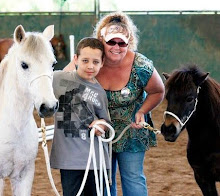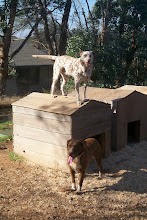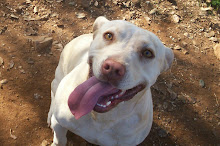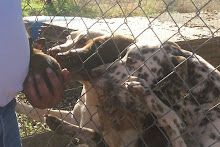Debunking the 'make the wrong thing difficult, right thing easy' theory. Well this is an eye opener. He talks about how most often, say in a round pen, we 'chase' a horse around, until it gives us two eyes. Of course we all know there is more to it than that....but in the interest of making the wrong thing difficult, when a horse wants to run rather than not, we make it run faster than they want to run....ie making it more work than the horse intended have. But a pshycologist attended a clinic of his, where before he had the chance to do anything with the horse, he noticed for the horse it was already difficult, so he chose to just let him run on his own, like his mentor had done with a horse years earlier. Anyways, the pshycologist came up to him to comment on it. He said that with trauma, the body goes thru physiological stages, one of which is to expend the energy of the trauma. That wild animals dont have problems with trauma because they can and do expend that energy, but that humans and domestic animals are usually not able to, thus the energy remains like a cancer, making us either physically or mentally ill, or both.....and that to chase or put preasure on an already running animal, is like adding trauma to trauma. Of course this is all explained better in the book, but I wanted to give an explanation for discussion sake.
So like the previous chapter where I mentioned my own 'problems' I am wondering if I too need to expend some energy. I know I have had to hold it all in, and not 'disturb the peace'....I am supposed to let it go and let by gones be by gones. I did intially expend a great deal of energy, of course it was directed in not so healthy ways, for me, but I did the best I could. I am thinking that it is just festering deep in me, and manifesting itself in other ways, that I am not able to correlate the two things as being related. Hmmm?
Anyways, he goes on about how that information changed the way he looked at horses....and thus he rarely uses the technique 'wrong thing hard, right thing easy' anymore. Figuring, if the horse doesn't understand what you are asking of him, it is probably already hard enough for him, why make it harder.
"It's funny how sometimes in life, we can look at something for years and years and years, and the picture never changes. Then suddenly, out of the blue, an new piece of information comes in. Even though the picture doesn't change,we start seeing that scene in a completely different light."
Wow this is so true....With my new information that I am learning in all these new and exciting places, especially with learning the way a herd leader really behaves, I am seeing my horses behavior in a totally different way. I havn't yet gotten myself sorted out, in the application department.....but inside I have to say, I feel so much better when I spend time with my horses....just being thier friend.
Savvy On
Michelle
Book: Whole Heart, Whole Horse by Mark Rashid
Sunday, March 13, 2011
Whole Heart: #5~ Trauma
Labels:
Book Reviews,
Horsemanship Ideas,
Michelle's Journey
Subscribe to:
Post Comments (Atom)


















I have this whole long response to this and the blog will not let me post it because it is too many characters :( DARN!!!!!!!!
ReplyDeleteWell break it into 2 comments....always love to hear thoughts of others ;)
ReplyDeletePart I
ReplyDeleteI usually love and agree with Mark, however, on this one I have to disagree. Based on his writings that I have read in the past I even disagree that he does not use this technique. If you think about it, all we are ever doing with a horse is making the right thing easy and the wrong thing difficult by using various kinds of pressure. In my opinion that is really what pressure does…makes the wrong thing difficult. In a calm horse this is an effective teacher and in my opinion probably the fastest teacher. Of course we want them to take the good deal first using as little pressure as possible but it is still in some way discomfort (not necessarily physical) aka making it difficult to do whatever else it is the horse is doing. If they don’t take the good deal first, what do we do, we up the pressure or phase if you will. At the end of the day it’s making the desired response easy no matter how polite about it we are. Until we are prepared to say I will no longer apply pressure of any type to my horse in order to motivate him, I do not think we can say that we do not use the “wrong thing difficult/right thing easy” technique.
Part III
ReplyDeleteIt appears in the example you showed from the book he may be speaking specifically to catching the horse that is ready to run. I still don’t agree this approach is not effective. Why is it ready to run? I think that is where it becomes important to read the horses state of mind. A lot of horses are not going to just come to you of their own free will. Especially a horse you have no relationship with. You have to do something to the horse to motivate it to join up. With an un-confident horse that is ready to run making it run in my opinion is not the answer. I think approaching until you hit its bubble and then reading its response and retreating will build trust and curiosity. Even that is the “wrong thing hard/right thing easy” concept. You continue to politely push on that bubble until it gets smaller you continue to play with its mind until it does something to get you to back off. The horse would rather you just went back into the house….that would be easy. On the opposite end of the spectrum asking a calm horse that just wants to graze to move its feet until it figures out that the coming to you is the sweet spot is a pretty effective method. On days my gelding finds the hay more interesting than me all I have to do is encourage him to move a little bit and suddenly I am the more attractive option and he comes right in. If I approached my new pony the same way to get her to catch me, it would cause her to fall apart and would probably take her an hour to stop running. I think it is all the same “wrong thing hard/right thing easy” concept applied differently with varying degrees and varying technique.
That is why there is no one catching game because every horse is different. That’s why we have to pay attention and why I think a lot of horse people get in trouble. They think one technique will fix every problem without taking into account each individual horse. That’s what we practice as horseman. How much pressure is right? What can the horse handle? How do a make the wrong thing difficult and the right thing easy for this horse?
OK well I have rambled on enough and I’m not entirely sure I conveyed what is in my head, but there you have it for what it is worth.
Thanks for posting something so thought provoking.
I clearly don't know how to use a computer and posted the comments in the wrong order. Sorry :(
ReplyDeleteI'm sure you will figure it out. Thanks again for a great post.
Part II
ReplyDeleteNow I agree that the approach to a scared horse is not necessarily applying a bunch more pressure but I think it depends on the approach and how it is used. This is one of the things that I disagree with in the Parelli program. When a horse is afraid applying pressure plus 4 oz does not build faith in a leader and in no way demonstrates an understanding of what that horse is going through. You become part of the problem. However, I do think that pattern interruption is effective which sometimes take a lot of pressure. So if the horse is running away scared I don’t think you should encourage the horse to continue running faster than it wants away from whatever the scary object is. First of all this is not safe for the rider or person on the ground. Second it shows that you are buying into the horse’s scared mentality and teaching the horse to respond that way to the scary situation. I do however think you should try to interrupt the thought process and behavior pattern by disengaging, backing…whatever and this may require quite a bit of pressure to accomplish with a horse in that mental state. I don’t think you should apply more pressure than needed but enough to be effective, in this case it just may be more than normal given the horses emotional state. Either way it is still making the wrong thing difficult. In this scenario you should not be trying to teach the horse anything, although I think they can learn, I think the goal is to get the horse to a safe state of mind. I think that sometimes when dealing with a scared horse the answer is to do nothing. It depends on what situation you are in. In the saddle on the trail if the horse freaks out; interrupt, interrupt, interrupt until the horse calms down and focuses back on you. Sometimes in a round pen it may be to just back off or walk away until the horse starts thinking again.
Believe it or not, I totally think the exact same thing when i read him write that. And i totally agree with you. And it is probably MY writing of 'debunking' the theory, that puts more light on the debunk than he does. So far, while he says it time and again, he doesn't give 'direct' explanation of the opposite. What I 'think' he means, is that if the horse is troubled we probably aready put too much preasure on him, and adding more is likely not to help this situation. the other thing i am thinking is that like so many other things i am learning, it is more a state of mind, than technique, per se. as many people seem to take that to the extreme, and make the worng thing 'impossible'. I truley felt what he was saying about adding trauma to trauma, and think the moral of the story might have had more to do with 'expending cancerous energy'. I think I will ask him about this next month when I meet him, and will get back to you. thanks to you for discussing it with me.
ReplyDeleteOh, also thinking about him writing that it is often easier to just stop, reset, and start again, rather than to try to stop the horse from doing the wrong thing. that the horse just doesnt understand, and that you likely asked in an unclear way, so stopping, getting more clear and going for the 're-do' is a good idea. of course it is situational, like you said, and not a law, but a tool.
ReplyDelete